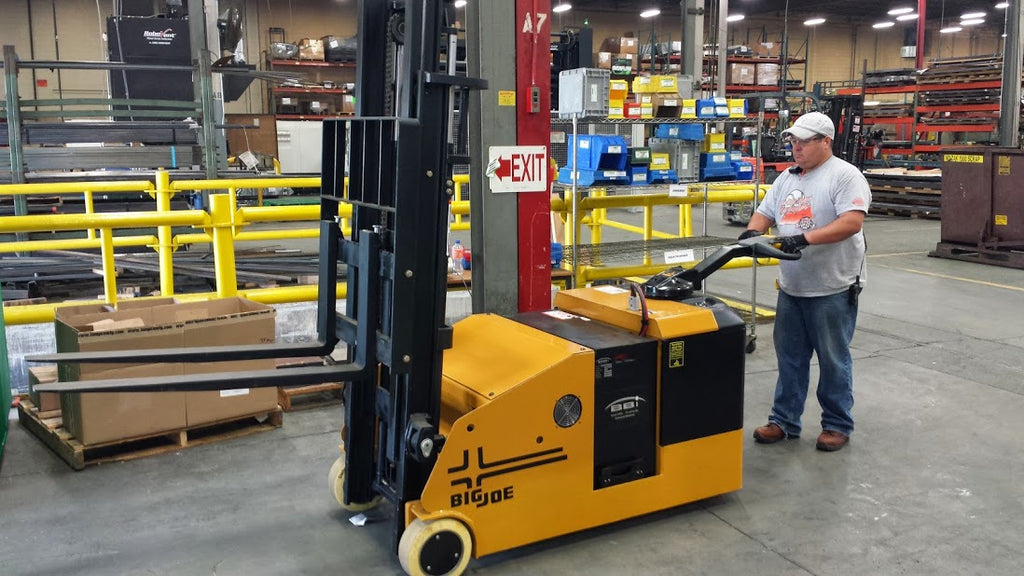By Kevin Pletch, Regional Sales Manager
There’s a popular slogan from an iconic motorcycle manufacturer I’ve seen on emblazoned T-shirts of lift truck operators for decades, “LIVE TO RIDE, RIDE TO LIVE.” To be perfectly clear, I’m an avid motorcyclist and I get it. There is no better feeling to me than taking my bike out on an open stretch of highway, but I sell walkie stackers to warehouses, DCs and manufacturers across eight states in the Midwest. When I put on my Big Joe shirt, my slogan is “LIVE TO WALK, WALK TO LIVE.” I’ve spent a large part of my career working with facility managers trying to change the cultural preferences for the riding lift truck and biases against the walkie stacker.
The fact is, riding forklifts can be dangerous pieces of equipment, and are the number one cause for pedestrian fatalities in the workplace. Drivers often exceed facility speed limits because the vehicle is capable of doing so and engage in risky maneuvering practices due to familiarity, arrogance or boredom. Even if they have driven down an aisle a thousand times, the one constant in a warehouse is change and an unexpected change can lead to a fatal accident.
WALK TO LIVE
Walkie Stackers are just plain safer. Maximum travel speed is a reasonable walking pace of just a bit over 3mph and with rearward facing forks during most travel, a walking operator has greater time to react and unimpaired vision. In the last 5 – 7 years, I have gained a powerful ally in the risk management and insurance industries. These experts are working to get operators off traditional riding forklifts due the high costs for injuries, liability insurance, lost time, operator training and certification, medical costs and comp claims.
We’ve all seen the studies about the dangers that riding forklifts present in the workplace:
- According to 2008 U.S. Department of Labor’s Bureau of Labor Statistics, the number one cause of lift truck related work fatalities is pedestrians being struck by a vehicle. (1)
- OSHA estimates that 110,000 lift truck accidents occur each year. (2)
- Approximately every 3 days, someone in the U.S. is killed in a forklift related accident. (2)
- Approximately 31,600 employees suffer some type of injury from a lift truck each year. (2)
- One in six of all workplace fatalities in this country are forklift related. (2)
- According to OSHA, approximately 70% of all lift truck accidents could have been avoided with proper safety measures. (2)
Clearly, the lethal combination of rider lift truck’s speed coupled with congested workplaces and obscured vision can be tragic, but the results can also be preventable. Unfortunately, many people have a negative perception of the walkie stacker due to the difficulty associated with manual steering.
Enter the CB33 and PDSR from Big Joe.
The march of time and technology has finally caught up with the concept, thanks largely to viable power steering systems on our modern walkie stackers. Previous attempts to adapt powered or power-assisted steering to walkie trucks had met with a tepid response to say the least. The components were large and clunky, the performance was lagging, and costs were high. Modern power steering systems feature miniaturized componentry and electronics with no direct connection to the steering wheel from the tiller, commonly referred to as “fly-by-wire” technology. Cumbersome chain driven systems have been replaced by direct driven servo motors, resulting in instantaneous response and precise control. The vehicles are safer and easier to operate from a complete stop through any travel speed. The advent of walkie stacker trucks with “fly-by-wire” power steering systems have revolutionized what can be done in a facility from management’s perspective, and what is acceptable to do from labor’s perspective. They are now truly viable systems that offer real performance advantages, while giving employees the benefit of dramatically improved workplace safety.
The CB33 and PDSR are workforce friendly platforms.
The walkie stacker operator has unimpaired vision and greater time to react.
The successful adaptation of power steering also has the power to change people’s minds. Employee acceptance of any new piece of equipment or operating procedure is key to the overall success of a program. Since the CB33 and PDSR require little effort to move the steering tiller and lower operator certification ratings, virtually anybody can be trained to use a walkie stacker. This breaks down workplace divisions of labor allowing for greater task assignment flexibility throughout a facility and reduces conflict when a rider operator is on vacation or out sick. More people can do more jobs which can reduce the feeling of being pigeon holed in a mundane task, helping to improve overall workplace morale and general productivity. Additionally, walkie stackers are more productive because the truck stays with the application it was intended for, unlike rider trucks which are often driven around by an operator trying to look busy or just killing time. This will lower the operating and maintenance expenses for a fleet of vehicles by reducing wear and tear and energy consumption. Power steering equipped CB33s or PDSRs often weigh half of what a comparably rated riding model does. This translates into lower floor loads and less physical wear on motors, pumps and transmissions. With operating costs of about 25% of a rider’s typical $2.50 to $3.00 hour operating cost, a walkie stacker has clear cost advantages for many recurring tasks
Warehouse conversion to a walkie stacker fleet of CB33s or PDSRs also brings the added benefit of narrower aisles and denser storage. With a tighter turning radius than any rider, incorporating a walkie stacker into your operation will allow you to reduce a standard twelve foot aisle down to seven in most cases. The ability to fit three racks in the space that formerly held two is an obvious advantage to the walkie’s owner.

Modern power steering technology makes the CB33 a viable alternative to riding forklifts.
This is not to say that the walkie stacker is the panacea for all workplaces or applications. There are many applications where a rider is the right choice. If your facility is large, the loads are very heavy, the racks are very high, and the throughput is great, keep some riders in your fleet. You can, however, supplement your fleet with task orientated walkie stackers to maximize productivity and reduce operating costs. Because they generally cost about one quarter of the price for a similarly rated class 4 rider, replacing even a few riding trucks with walkie stackers can have a tremendous impact on the bottom-line operating expenses of a facility.
(1) U.S. Department of Labor
(2) “Towards improved forklift safety” National Institute of Standards and Technology, Oct 2009 – Bircher America, Inc.


